
by Sheila Dunning | Apr 9, 2019
 Call 811 before you dig. No one wants a weekend project to be the cause of Internet, phone and cable outages. Worse yet, what if someone gets hurt from contact with natural gas or electrical lines? That’s why it is so important to have buried utilities in the yard located and marked before digging. Sunshine 811 coordinates each individual company to clearly mark where the service lines are located. Homeowners are required by law to contact 811 three days before any soil removal is done. The service is free.
Call 811 before you dig. No one wants a weekend project to be the cause of Internet, phone and cable outages. Worse yet, what if someone gets hurt from contact with natural gas or electrical lines? That’s why it is so important to have buried utilities in the yard located and marked before digging. Sunshine 811 coordinates each individual company to clearly mark where the service lines are located. Homeowners are required by law to contact 811 three days before any soil removal is done. The service is free.
Have information prepared before making the request. Describe the work to be performed (e.g. fence install, landscaping, irrigation install), including the type of equipment that will be used. Specify the exact location on the property and how long the work will continue. Finally, provide all the contact information (e.g. name, phone number, e-mail), should there be any additional questions.
Call 811 or request a single address ticket online. Receive a ticket number and wait two full business days, not counting weekends or holidays. Then contact 811 again. Make sure that all the utilities have responded in the Positive Response System (PRS). Sometimes that may mean that the company doesn’t have anything to make in the area.
If there are utility lines running through the yard, they will be marked with specifically colored paints or flags. Red is used for electrical lines, orange indicates communication lines, yellow means gas, blue is used for potable water, purple is reclaimed water, and green indicates sewer lines. White lines may be used to outline digging areas and pink are temporary survey marks. This is the APWA Uniform Color Code.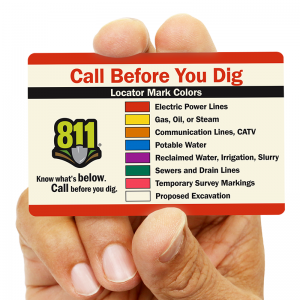
Every effort is made to locate the lines as accurately as possible. But, the safest thing to do is hand dig to expose the utility line before using any mechanized equipment. Lines can vary up to 24” from the marked line and depths can be less than 5”. Remember there may be access lines running through the property even if that service isn’t utilized at that address.
Keep safe this spring. Call 811 before digging.
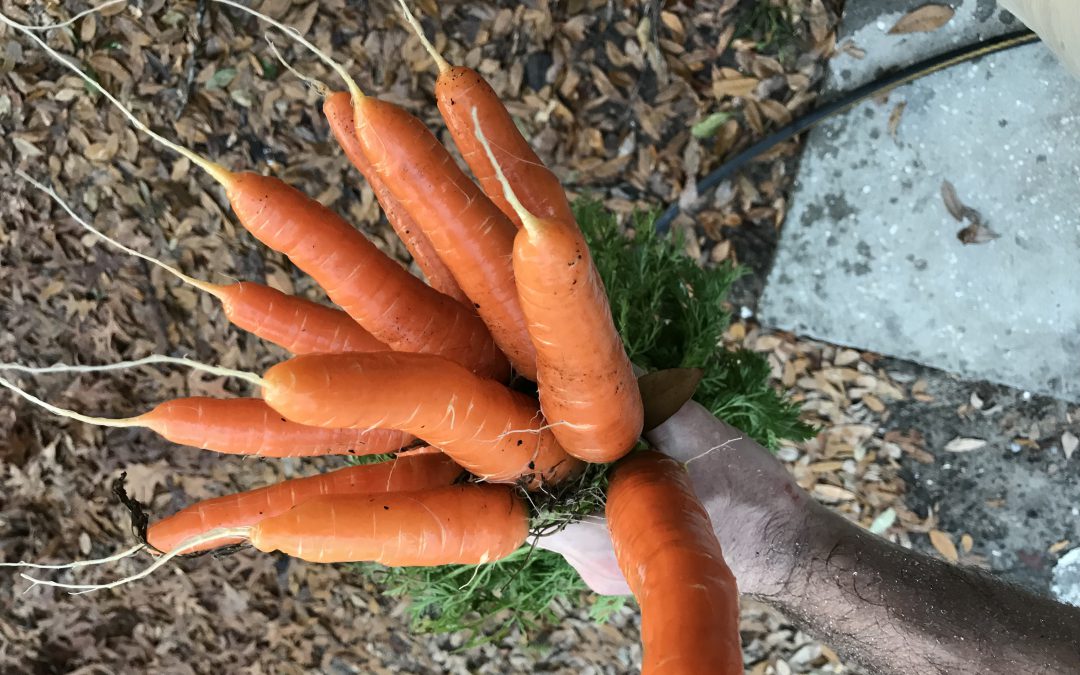
by Daniel J. Leonard | Apr 8, 2019
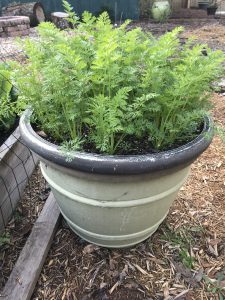
Carrots growing in a large container.
After tending a home vegetable garden for any length of time in the Panhandle, you begin to learn some things. Tomatoes are awfully hard to grow. Raised beds drastically lower the difficulty of gardening in general. You should never plant mint in a permanent veggie garden. Swiss Chard has to be started early because it grows as molasses creeps. Of all of these anecdotal maxims I’ve discovered, the one with the most flavor return on my gardening investment is that carrots should always be a part of your cool season garden. A fresh carrot out of the garden is hard to beat. The difference between a grocery store carrot and one fresh out of your own garden is astonishing and will change your culinary life. Though carrot season in Florida is just ending (my final batch was harvested yesterday), it’s the perfect time to learn about growing carrots here and plan to get some in the ground this fall!
There are a number of reasons to grow and eat carrots. They’re obviously very healthy, though I dispute the whole eat carrots and you’ll have great eyesight thing – apparently I acquired the taste for them too late to help. They go well in more dishes than they don’t. However, the real two reasons you should supplement your grocery store carrot purchases with home grown harvests are that they’re so easy to grow and that there are so many more options than the standard long, thin orange varieties adorning the produce aisle shelves.
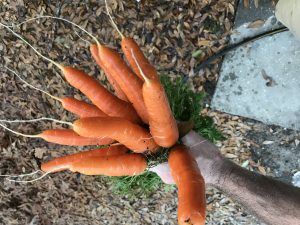
‘Bolero’ Carrots
Though carrots are remarkable easy to grow, they do ask a couple of things of gardeners. They are a cool season vegetable and are generally planted from seed beginning in late August through early September in the Panhandle, though successive plantings can continue through at least February if you want to extend your harvest. Also, like many other root vegetables, carrots don’t transplant well so direct seeding in the garden is a must. But before you even consider seeding, care must be taken to make sure the soil bed you’ll be seeding in has been properly prepared. One of the few ways to fail growing carrots is to not start with a loose soil free from any potential obstructions. If the development of the carrot root is disturbed by anything during the germination and growing process (this includes manure aggregates or other clumpy soil, sticks, rocks or even a hard layer of soil hiding under your loose compost), the end product will be deformed. To prevent this, thoroughly till your raised bed soil to at least 12” and break up any larger soil particles that are left with your hands. If you don’t get your soil bed perfect though, fear not, deformed carrots are definitely edible, they just won’t look like they’re supposed to and are more difficult to clean and process!
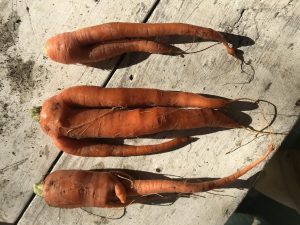
Deformed carrots due to clumpy compost!
Once you’re ready to plant, I’ve found it easier on poor eyes and fumbling fingers like mine to sprinkle the tiny carrot seeds in shallowly furrowed rows 10”-12” apart and thin the seedlings later, rather than trying to individually space seeds the recommended 1”-3” apart. Finally, these colorful little veggies love water and require good fertility. To ensure good expansion of the edible root, maintain consistent moisture and fertilize at planting with a good slow release fertilizer. Additional fertilizer applications may be required later in the growing season as most carrots take around ten weeks to gain maturity.
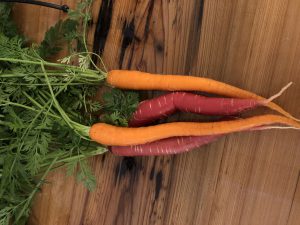
‘Sugarsnax’ (orange) and ‘Malbec’ (red) carrots
In this age of online catalogs, farmer’s markets, and demanding consumers who crave interesting food, the selection of carrot varieties available for gardeners to grow has never been better. Among the hundreds of individual cultivar options are several broad types of carrots you’ll need to choose from. You’re probably familiar with the Imperator types. These are the extra-long, durable carrots most often find in stores. If you have a deep raised bed or other large container, Imperator varieties can be extremely rewarding! I grew the Imperator-type ‘Sugarsnax’ this year and highly recommend it for ease of growing, size and flavor. Next up are the Nantes types. These carrots are medium length and cylindrically shaped. Sometimes called “storage” carrots, these types tend to store well for long periods of time after harvest and retain their flavor well. I’ve tried a few over the last several years and can recommend ‘Bolero’ and ‘Napoli’ with confidence. There is even a carrot type for those of you with shallow raised beds (8” or less) that can’t accommodate the previously listed types! Chantenay type carrots are excellent performers in these situations as they are generally a bit shorter and possess a conical shape with roots wider at the top and tapering to the tip, making a deep soil bed a bit less critical. Finally, there are even some excellent cultivars of carrots in colors other than orange! That’s right, you can grow white, purple, yellow, and even red carrots! I’ve done very well with ‘Purple Haze’ (purple with orange interior), ‘White Satin’ (creamy white color), and ‘Malbec’ (deep, rich red) and highly recommend all three. Keep in mind that the red and purple carrots tend to lose their color when cooked, so the greatest effect is seen when eaten fresh. All of these cultivars can be found at nearly any of the numerous online and catalog seed retainers such as Johnny’s Selected Seeds, Baker Creek Heirloom Seeds, Burpee, and others.
As you can see, carrots are an easy to grow, extremely rewarding vegetable for the home gardener; give some a try in your raised beds next fall! And as always, if you have any questions about growing carrots or any other gardening related question, contact your local UF/IFAS Extension office!
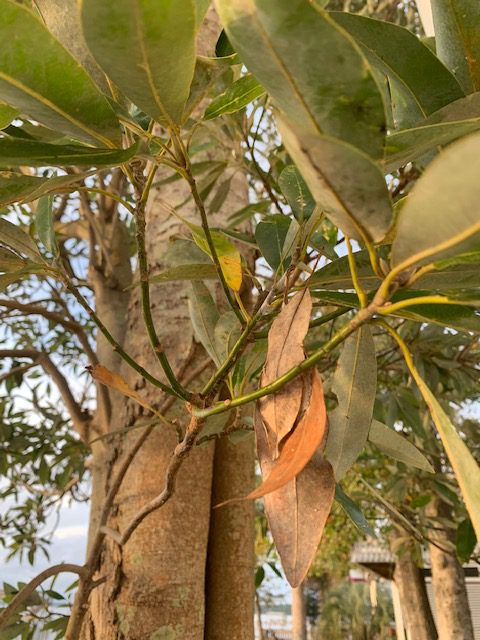
by Mary Salinas | Feb 26, 2019
You never know what you’ll find when you start looking closely in your garden. I was puzzled as to why there were three dead leaves hanging together on my sweetbay tree when all the other leaves looked so nice and healthy. On further investigation, I found a cocoon was made by binding the leaves together and it was firmly attached to the branch with silk.
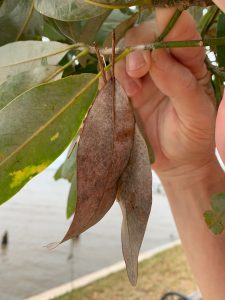
The hanging dead leaves are a perfect hiding place for the cocoon of the sweetbay silkmoth. Photo credit: Mary Salinas.
This is the cocoon of the Sweetbay silkmoth, Callosamia securifera. Adult females lay their eggs on the native sweetbay tree, Magnolia virginiana, as the caterpillars only feed on sweetbay leaves. The trees tolerate having a few leaves eaten so there is no need to pick off the caterpillars if you find them. Local birds may do that for you as they rely on an abundance of caterpillars to feed their baby birds.
See photos of this beautiful moth with more details on its life cycle.
And then explore Gardening with Wildlife on UF/IFAS Gardening Solutions.

by Carrie Stevenson | Feb 26, 2019
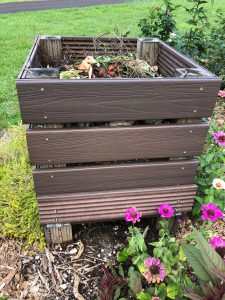
Compost bins can be built or purchased and provide an easy means of recycling food and yard waste into valuable soil for a garden. Photo credit: Carrie Stevenson, UF/ IFAS Extension
What better New Year’s resolution could there be than to start recycling and do our part to preserve our natural resources? By composting yard and kitchen waste, we can also get a jump-start on our spring gardening by creating your own mulch and fertilizer. Done properly, raw compost material can transform into nutrient-rich soil in just six weeks! A free source of “slow release” nutrients, compost also loosens tight, compacted soils and helps our often-sandy soils hold nutrients.
So what is compost? Essentially, it is what’s left of organic matter after it’s been thoroughly decomposed by microbes. Among the common compostable organic materials are leaves, grass clippings, twigs, pine straw, and vegetable/fruit peelings and coffee grounds. When using these items, alternate by using brown (leaves, straw) and green materials (grass clippings, vegetables) in the compost bin to provide adequate carbon and nitrogen. Table scraps containing meat, eggs or oils are not recommended because they can draw rodents and cause an odor. Eggshells are OK, but in general, use only kitchen scraps that are either plants or paper.
The organisms doing the actual composting are microscopic bacteria and fungi, along with earthworms. The microbes need water, oxygen and nutrients to thrive. Rainfall will provide most of the needed moisture, although you may need to hand water the pile on during dry times. For the best results, keep the pile moist but not soggy; if you pick up a handful it should not crumble away nor drip water when squeezed.
To move oxygen through the pile, increasing decomposition and preventing odors, turn the pile on a regular basis with a pitchfork or rake. Some companies sell compost bins in moving cylinders that can be turned with a handle. The process of decomposition will generate extreme heat (over 150°F in the summer) within the pile, which can kill weed seeds and disease-causing organisms.
Done correctly, composting does not smell bad, is very easy to do, and is a great way to do something good for the planet, your yard, and your wallet! Learn more about composting at this University of Florida Extension article.

by Ray Bodrey | Feb 5, 2019
The “new” or “Irish” potato is one of America’s most popular vegetables and a fine cool season crop choice for gardeners in the Panhandle.
The history of the potato is quite interesting. The potato was first domesticated in Peru between 3000 BC-2000 BC. Potatoes were first planted, where in states? Idaho, of course, as early as the 1830’s. By 1900, Idaho’s production exceeded one million bushels. Potatoes are diverse in appearance and uses. Potatoes are high in nutrition and have fewer calories than other starches such as rice, pasta and bread.
In Florida, potatoes can be planted in the winter or early spring. February 1st to March 10th is the prime planting range. As a general production rule, 100 lbs. of seed potatoes will typically yield around ten bushels. Be sure to use only certified seed potatoes for best planting stock. These can be found at most garden centers. For best results, select varieties recommended for North Florida like ‘Atlantic’, ‘Sebago’, and ‘Superior’ (all round, white potatoes). Also, ‘Red Lasorda’ and ‘Red Pontiac’ are viable round, red potatoes. Resist using potato stock bought from produce sections at grocery stores. Odds are, symptoms of a number of diseases will occur. For planting, each seed potato should be cut into smaller pieces, displaying two or more eyes. To prevent fungal pathogens, the most common culprit in potato production, use a light dusting of a fungicide to combating decay.
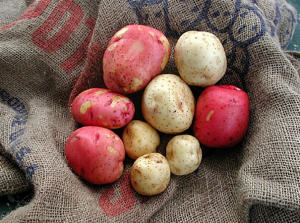
Figure 1. Red and white potatoes grown in Florida.
Credit: C. Hutchinson. UF/IFAS Extension
It’s best to plant seed potatoes in raised rows, where the height of the mound is 6 inches and the width is 1 to 2 feet. Row spacing should be at least 3 feet apart. The seed furrow should be 3-4 inches in depth, through the center of the row. Seed potatoes should be planted in 1 foot intervals. Cover, and water freshly planted rows. Fertilizing is key. One quart of 10-10-10 fertilizer for every 50 feet of row space is needed for the initial application. Through the season, for every 3 weeks, side dress the rows with a pound of 10-10-10 per 50 feet of row space.
Following these steps will ensure a productive potato crop. For more information please contact your local county extension office.
Supporting information for this article and further information can be found in the following the UF/IFAS EDIS publication: “Growing Potatoes in the Florida Home Garden” by Christian T. Christensen, Joel Reyes-Cabrera, Libby R. Rens, Jeffrey E. Pack, Lincoln Zotarelli, Chad Hutchinson, Wendy J. Dahl, Doug Gergela, and James M. White: https://edis.ifas.ufl.edu/pdffiles/HS/HS18300.pdf
UF/IFAS Extension is an Equal Opportunity Institution.
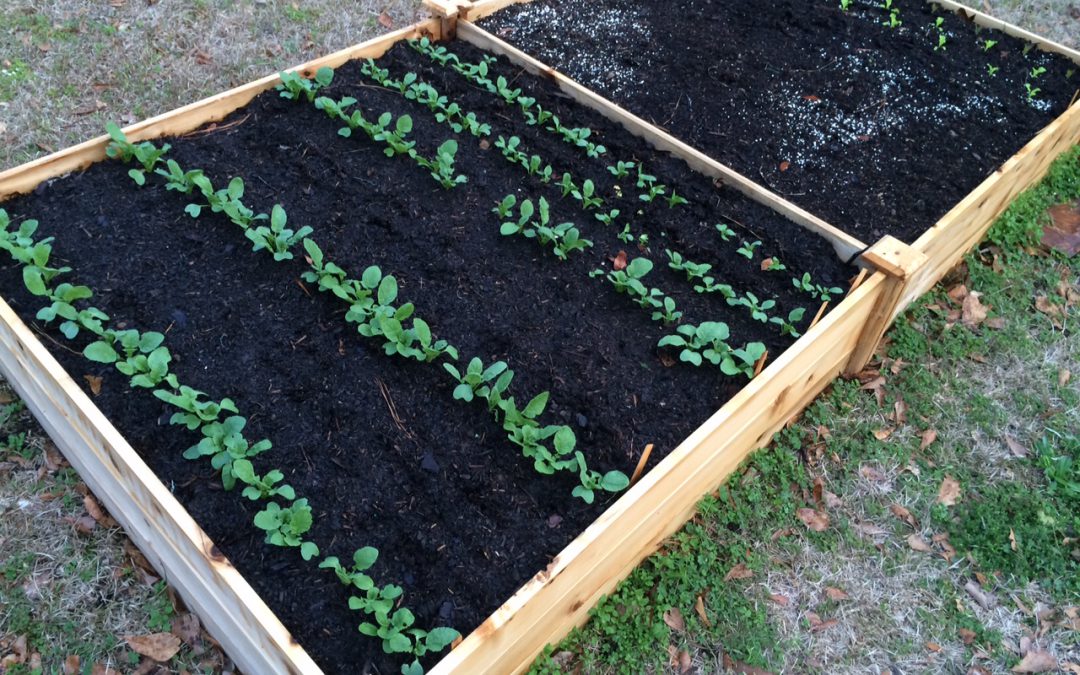
by Molly Jameson | Jan 14, 2019
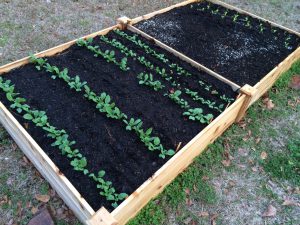
Raised beds are an excellent way to get started with gardening. Photo by Molly Jameson.
One of the biggest obstacles a vegetable gardener faces is how to supply crops with healthy soil that can support crop growth all season long. Many native soils in Florida are stripped of imperative nutrients that crops need to grow, are too compacted from vehicle and foot traffic, and are often too sandy to support soil life, which is very important for nutrient cycling, building soil structure, and combating pests and diseases.
One of the best ways a gardener can ensure a successful gardening experience is to build a raised bed garden. No matter your native soil type and existing conditions, raised bed gardens allow a framework for building nutrient rich soil that can supply crops with what they require to grow healthily and thrive.
Want to learn how to garden using raised beds? On February 5, from 6:00 to 7:30 p.m., UF/IFAS Extension Leon County is offering a Raised Bed Gardening 101 workshop as part of the Red Hills Small Farm Alliance’s Seven Days of Local Delights. This is a week-long annual celebration that includes educational workshops, restaurant partnerships, fundraisers, and more that supports the local food community and farmers in the Red Hills Region. This year, the Seven Days of Local Delights runs from Sunday, February 3 to Sunday, February 10.
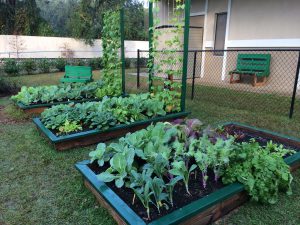
A trellis can even be built right on the end of a raised bed. Photo by Molly Jameson.
At the Raised Bed Gardening 101 workshop, learn how to choose the best raised bed garden site location, basics of irrigation in raised beds, planting dates and plant spacing, the difference between treated and untreated lumber, how much and what type of soil to use, and other tips on growing food in your backyard.
There is no cost to attend, but please register on Eventbrite (https://sdldraisedbedgardening101.eventbrite.com). For more information, contact Molly Jameson at mjameson@ufl.edu.
Check out everything going on during the Seven Days of Local Delights at the Red Hills Small Farm Alliance website: https://www.redhillsfarmalliance.com/seven-days. If you are not in the Tallahassee area, check with your local extension office to see what gardening events they may have available and how you can support your local food community and farmers in your area.

 Call 811 before you dig. No one wants a weekend project to be the cause of Internet, phone and cable outages. Worse yet, what if someone gets hurt from contact with natural gas or electrical lines? That’s why it is so important to have buried utilities in the yard located and marked before digging. Sunshine 811 coordinates each individual company to clearly mark where the service lines are located. Homeowners are required by law to contact 811 three days before any soil removal is done. The service is free.
Call 811 before you dig. No one wants a weekend project to be the cause of Internet, phone and cable outages. Worse yet, what if someone gets hurt from contact with natural gas or electrical lines? That’s why it is so important to have buried utilities in the yard located and marked before digging. Sunshine 811 coordinates each individual company to clearly mark where the service lines are located. Homeowners are required by law to contact 811 three days before any soil removal is done. The service is free.














